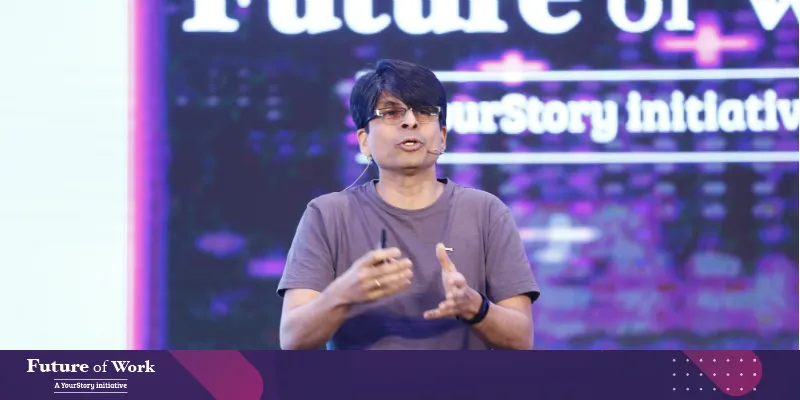Future of Work 2020: Aadhaar’s Chief Architect Pramod Varma on building the world’s largest biometric identity system
At YourStory’s Future of Work 2020 conference, Pramod Varma, the Chief Architect of Aadhaar and India Stack spoke about the experience of building technology for a billion people.
Aadhaar is the world’s largest biometric identity programme covering about 16 percent of the world’s population. It also holds immense potential in improving public service deliveries and fostering digital and financial inclusion.
As India's digital identity program, has successfully covered more than 1.25 billion people. It is also one of India’s best case studies of scale. In addition to core digital identity systems, India's open digital infrastructure, collectively known as India Stack, also includes electronic payment, digital signature, digital locker, and data empowerment as its core layers.

Pramod Varma, who is the Chief Architect of Aadhaar and India Stack layers spoke about the experience of building these country scale systems. He was speaking at the third edition of YourStory's Future of Work, India's largest product-design-tech conference, on Saturday.
Architect of the world's largest identity project
When Pramod Varma took on the challenge to architect the world's largest identity project (almost 10 times bigger than the largest existing identity system), he didn't have much idea of what he was up to. But driven by instinctive decision-making and armed with a firm in people's capabilities, Pramod made Aadhaar one of the most robust and scalable systems, achieving the goal of inclusion like none other.
Open digital infrastructure has hugely helped societies access information, products, knowledge, and collaborate better with each other. India has also benefited from hundreds of millions of people having access to mobile phones and the internet.
It is essential that from time to time many such digital infrastructure layers are built as public goods to create open access and a level playing field for innovators to provide solutions to large diverse society. India has been building its own layers of public digital infrastructure spanning from identity, payment, health to education.
Before and after Aadhaar
To understand the scale and success of Aadhaar, it is important to look at the landscape before the programme was introduced; and Pramod set the context with a few statistics.
Back in 2008, financial inclusion was really low -- just 17 percent of India’s population had bank accounts. And while around $50 billion was being spent on subsidies, diversion and leakage was rampant. This caused a ripple effect. Getting a loan was near impossible for citizens from the lower socio-economic rungs. Customers with the lowest default rates had the highest interest rates because of no credible data.
Besides helping realise 80 percent financial inclusion in just six years and proving naysayers wrong, Aadhaar helped disrupt the financial innovation through eKYC particularly in the mutual fund and neo banking arena.
A centralised database and authentication system, like Aadhaar, works better than a distributed system where each bank builds and maintains the biometric database of its own customers. Collecting the biometric information of a customer is a long and expensive process. The high entry costs associated with a distributed system make moving one’s account between banks a cumbersome process.
A centralised system, like Aadhaar Enabled Payment System (AEPS), makes it easy for a new financial services provider to plug-in and launch its services. A widespread network of agents associated with different banks, operating on AEPS, would expand the choice set for the customer, increase competition and improve customer service.
Flexibility in using the branch, agent or biometric ATM (Automated Teller Machine) to access bank account would put such a customer on an equal footing with the customers who access the existing network of ATMs using a card and PIN (Personal Identification Number) for authentication. The choice of authentication system would no longer define the extent of access to the banking network.
India now runs the world’s largest direct cash transfer programme with over $35 billion now directly being sent to the bank account of the beneficiary, resulting in savings to the tune of $5 billion, as per government estimates.
The system has also seen over 33 billion Aadhaar-based authentications and over 7.5 billion e-KYC transactions, 200 million micro-ATM transactions and 1.3 billion UPI transactions a month till date.
Open digital infrastructure: a gamechanger for the industry
India is one of the first countries in the world to start Open APIs (Application Program Interface) for consented financial data sharing, and Pramod spoke about how they worked to keep minimalism and openness at the very core.
Keeping it simple and minimalistic, Aadhaar focused on a few parameters of storage as compared to other countries attempting to store 50 plus parameters, that had to be got from multiple sources leading to bureaucratic tangles. Aadhaar also did not invest in field infrastructure but just the strong, secure, scalable backend exposed via APIs and ecosystem partners invested and participated in the fastest growth of a billion users worldwide.
Key takeaways from building the India stack
Wrapping up his talk, Pramod left the audience with a few key learnings on implementation.
1. Think unified, not uniform. Your solution should have the ability to create and coexist diverse solutions on shared infrastructure.
2. Unbundle, unbundle, unbundle. Think small. Build digital infrastructure that solves multi-dimensional challenges.
3. Design interoperability through specifications with the ability to connect and combine microservices to create solutions.
4. Adopt open standards and open source, because openness eventually wins.
5. Design for retractability and build observability through telemetry.
6. Plan for scalability via design and build failure resilience into every microservice.
7. Strive for data minimalism. Create privacy and security by design.
8. Build trust by design. Increase trust through registries, attestations and signatures.
9. Adopt extreme automation. Every repeated task and API testing must be automated, period!
10. Keep it super simple. Simplicity is key. Eliminate feature creep. But if required, layer them.
(Edited by Ramarko Sengupta)
A big shout out to our Future of Work 2020 Sponsors: Alibaba Cloud, Larksuite, Vodafone Idea Limited, Gojek, Adobe, Udaan, Pocket Aces, Junglee Games, ShareChat, Open, Vesta Space Technology, Maharashtra State Innovation Society, Kristal.AI and GetToWork; and our Knowledge Partner: Ascend Harvard Business Review.










